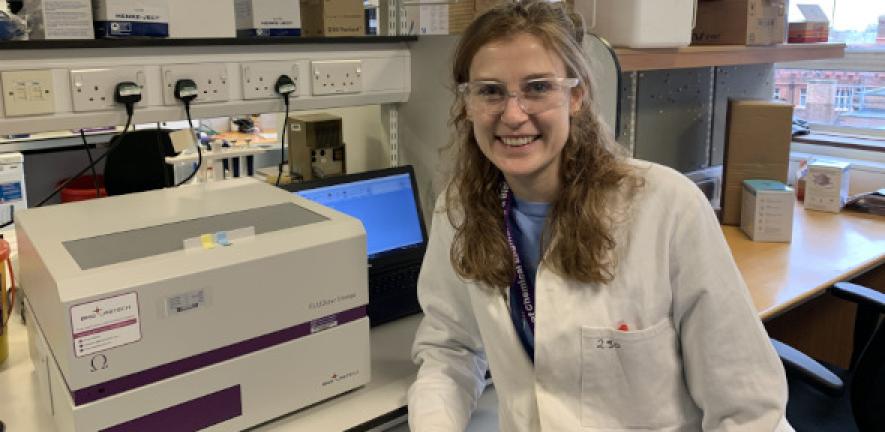
From academia and back again
Katie completed her undergraduate studies at the University of St Andrews, receiving a Chemistry MChem (Masters degree). She enjoyed the science, but rather than continuing immediately to a PhD, she wanted to get experience in a real-world industry setting. Katie, as she prefers to be called, began working with drug discovery company Almac Discovery in her native Belfast before joining AstraZeneca as part of their Innovative Medicines & Early Discovery graduate scheme (now called R&D Graduate Programme).
Katie was drawn to the AZ scheme because it involved rotations in three different fields – Structural Analytical Chemistry using NMR, Synthesis and Medicinal Chemistry, and Mass Spectrometry -- all of which interested her. Working at AZ also rekindled her interest in research, and after three years in industry she entered the PhD programme at the Cambridge EPSRC Centre for Doctoral Training in Sensor Technologies for a Healthy and Sustainable Future. The CDT provides an interdisciplinary training programme in all areas of sensor technology, development and end use. As usual, one of the aspects Katie has been enjoying is working with and learning from other students at the CDT in fields like biology, computer programming or chemical engineering.
CDT and Peptide research
When it came time to choose a research project through the CDT, Katie found she was drawn to Professor Sophie Jackson’s research in peptides, which are chains of amino acids typically shorter than proteins. Because therapeutic peptides represent a large class of existing and new drug therapies, it is essential that they are produced in uniform batches so that results are verifiable and reproducible. “Therapeutic peptides are very well and heavily controlled, but it is important to work out how we can improve them, and monitor and control their safety and efficacy,” explains Katie.
Therapeutic peptides also have the potential to self-assemble into fibrillar structures, known as peptide aggregates. The aggregates influence drug formulation and delivery, which makes their development very challenging. Aggregates are especially important to consider when trying to make uniform and consistent batches. Katie is investigating what part of making and purifying a peptide affects when and how it starts to form fibrils, a process known as peptide fibrillation, with a view to minimising the variation between batches.
As part of her research Katie makes batches of her own synthetic peptide, and characterises them in as many ways as possible, using traditional biophysical techniques as well as structural mass spectrometry. “Reducing inconsistencies or variables in batches of peptides is critical to the integrity of the eventual research results,” she says. “Managing the physical stability is one more thing you can control to ensure the batches you are working with behave consistently.”
Interestingly, when Katie started at the CDT her PhD was funded by Medimmune, which has since been fully incorporated into AstraZeneca, so in a way she has come full circle. Katie is based at the AstraZeneca lab in nearby Granta park, although she also has regular contact with other Jackson group members through weekly Zoom meetings and social activities when Covid restrictions allow. This has definite advantages: “There’s three of us working on similar projects with different angles and sub-specialities, so it’s nice to have people to bounce ideas off.”
LERU summer school
In 2021 Katie was selected in a university-wide competition to attend the LERU Doctoral Summer School, a prestigious international summer school organised by the League of European Research Universities, a network of research-intensive universities.
The five-day annual event provided around 50 doctoral candidates from different disciplines across Europe with unique professional and personal development opportunities beyond their PhD training.
Katie’s enthusiasm for inter-disciplinary collaboration is one of the things that led her to apply. “The summer school is for lots of different disciplines, and I had a real desire and enthusiasm for learning about the topics they were going to present,” she says. She was chosen after a rigorous selection process first by the Department, then the School of Physical Sciences, and ultimately the University.
Although, due to Covid, the courses were held online, this does not dim Katie’s enthusiasm for the programme, which she says was “eye opening.” “The central idea of the summer school was to explore the importance, value and role of experts in life. We are doctoral students on the path toward becoming experts, and we explored how we can do that well, and how we network, collaborate with and understand other experts.”
This suited Katie’s interdisciplinary interests and desire to bring the joy and importance of science to a wider audience. “I think I currently do struggle to discuss what I do and why I do it, with people who don’t have a scientific background. I want to make sure I can tell them accurately in a way that makes it feel important for them. Having been given the opportunity to study science at the level I have, I feel I have a responsibility to communicate openly and appropriately . The summer school made me more aware of the importance of knowing where my ‘expertise’ begins and ends, as well as highlighting the challenges or expectations facing early career researchers- unsurprisingly with a lot of discussion regarding the use of social media.”
The course has encouraged Katie to think more deeply about science communication, an area she has long been interested in, and for her future, Katie does not envision continuing laboratory research. “After this, I think I would like to be the effective communicator of other people’s science.”

